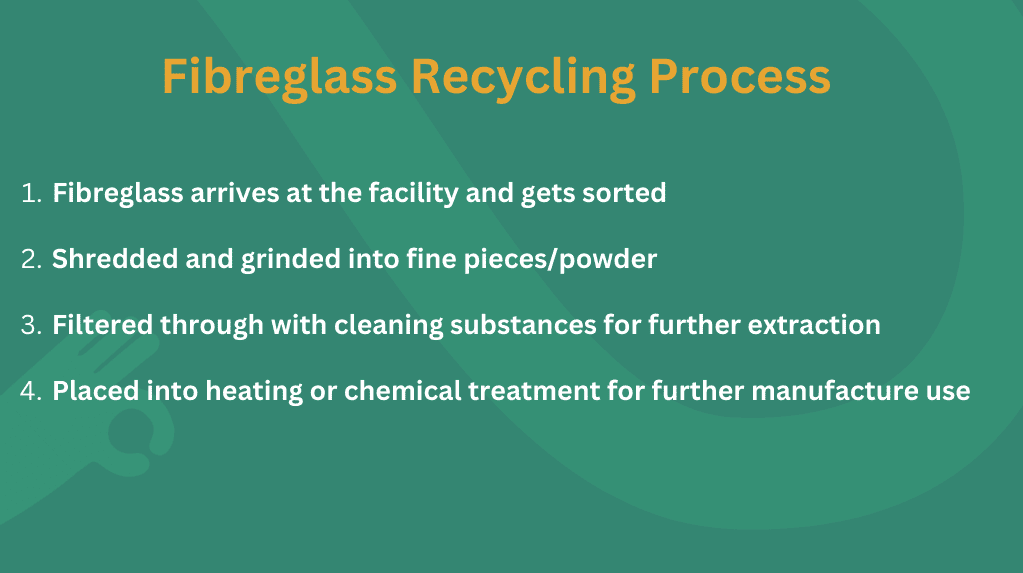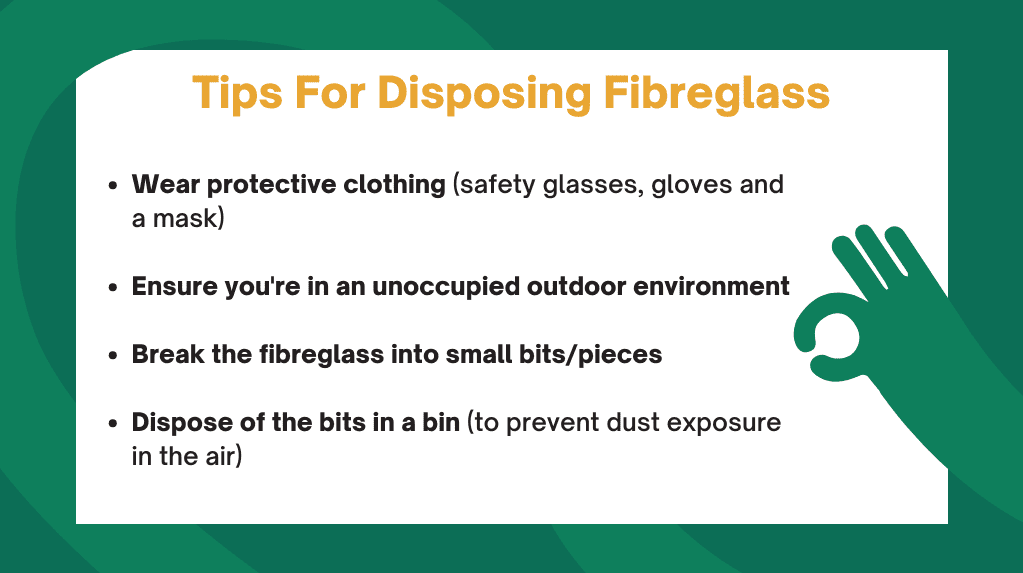
Fibreglass — can it be recycled, and where is it supposed to go when you want to get rid of it?
Most of us are aware of the existence of fibreglass as a material, but when it comes to disposing of it, many are stumped as to whether it belongs in the yellow mixed-recyclables bin , the red general waste bin, or whether it needs to be treated with an extra level of care befitting of hazardous materials.
In this article, we’ll go through what you can (and cannot) dispose of when it comes to recycling fibreglass and how you can do it without harming the environment.
Table of Contents
- What is fibreglass?
- Can fibreglass be recycled in Australia?
- The fibreglass recycling process in Australia
- How to dispose of fibreglass correctly
-
- Types of recyclable fibreglass items
What is Fibreglass?
Fibreglass is a type of fibre-reinforced plastic made from interwoven strands of glass fibre that gives it its durable yet flexible characteristics. It’s most commonly used in boats, swimming pools, hot tubs, surfboards, and even housing insulation.
Here are the main types of fibreglass:
- A-glass: Known as alkali glass, this type of fibreglass is resistant to chemicals and has some similarities to window glass.
- C-glass: Chemical glass is mainly used in industrial applications due to its resistance to chemicals.
- E-glass: Electrical glass is an excellent insulator of electricity.
- AE-glass: Alkali-resistant glass is used in conjunction with concrete applications.
- S-glass: Also known as strength glass, S-glass is used for its high tensile strength.
Can Fibreglass be Recycled in Australia?
Yes, fibreglass can be recycled in Australia. When fibreglass is no longer fit for use or is being disposed of, it can be broken down into its constituent elements and reused to make new composite materials.
Most recycling facilities in Australia and NSW are equipped with the necessary equipment to recycle fibreglass. Still, it’s always a good idea to check with the facility ahead of disposal to confirm that they accept fibreglass.
However, the recycling process for fibreglass isn’t as simple as it is for other materials like wood or metal. As a composite material made of multiple other resources that have been chemically bonded together, it needs special treatment before it can be broken down into a reusable form.

The Fibreglass Recycling Process in Australia
Depending on the type of fibreglass, the recycling process can vary due to the specialised treatments needed to break the material down. In general, most fibreglass items will undergo the following steps to be recycled:
- The fibreglass materials will be sorted based on type and colour.
- Fibreglass materials are shredded and grinded down into tiny pieces or a powder for ease of processing.
- Broken down fibreglass is filtered through with cleaning substances to remove other substances.
- As a final step, the fibreglass material is then put through heating or chemical treatment to prepare it for use in the manufacture of other materials.
This current process for recycling fibreglass is still being improved upon, as it is very difficult to separate the chemically bonded plastics into more usable forms. As a result, recycled fibreglass is usually only used as a filler material for lower-grade composite materials.
How to Dispose of Fibreglass Correctly

Breaking or grinding fibreglass into smaller pieces to fit the bin may be a necessary part of the disposal process, but it’s not without its dangers.
When attempting to dispose of fibreglass, many people make the grave mistake of smashing it into smaller pieces without proper protection. Fibreglass is an extremely strong material and can shatter when struck, and the sharp pieces that break off it can easily cut the skin and flesh. In addition, tiny particles of fibreglass dust can be released into the air, which may cause irritation in the eyes, skin, and respiratory system.
Proper disposal of fibreglass will require you to:
- Wear protective clothing such as gloves, safety glasses, covered shoes, and a breathing mask.
- Perform the breaking down of fibreglass in an unoccupied outdoor area.
- Only break the fibreglass into small enough pieces to fit in the bin.
- Bag up the bits of fibreglass to prevent dust exposure to the air.
Alternatively, you could take the safer route and engage the services of a professional rubbish removal company. Having an experienced team of removalists to assist you with fibreglass disposal will ensure that it is done safely and responsibly, giving you peace of mind.
Types of Recyclable Fibreglass Items

Identifying which items contain or are made of fibreglass can be difficult, especially since its appearance bears much similarity to plastic or glass.
To help guide you in your disposal of fibreglass waste, here are some examples of everyday fibreglass items you may find in your household:
- Housing insulation — As an insulation material, fibreglass can appear like cotton or cloth fibre.
- Surfboards — Many modern surfboards are made from fibreglass.
- Vehicle body parts — Some vehicles' spoilers and body panels are made of fibreglass.
- Boats — Fibreglass is one of the main components of boat hulls.
- Pipes or tubing — Old piping can be lined or made of fibreglass.
Final Thoughts
Recycling fibreglass is possible, but it is also a time and energy-consuming process. This often results in improper disposal of fibreglass, whether into the wrong bin or, worse, illegally dumped on the side of the curb.
As a rubbish removal company that puts sustainability at the forefront of everything we do, we want to provide a safe and easy alternative to fibreglass disposal and help in the fibreglass recycling process. If you have fibreglass rubbish that needs to be cleared, Ridly can remove it for you quickly and efficiently, even on the same-day you contact us.